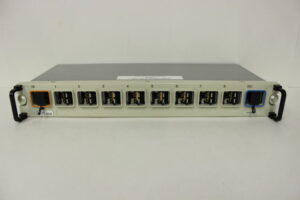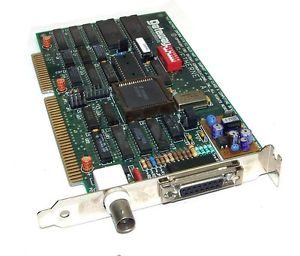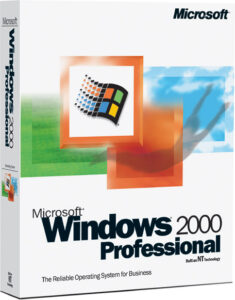Sometimes it’s a beautiful combination of laugh-inducing and cringeworthy as we look back on the start of our careers in IT. University and College students starting this September will have grown up entirely post-Y2K. Having grown up in enterprise IT through the 90s, I bet that you can share these things that will make you smile a little.
Feel free to drop in comments with your own fun memories of technology in your career!
Token Ring
 That’s right, folks. Ethernet wasn’t the first networking that was adopted in the enterprise. As a 90s administrator, you’ll remember the pre-switching days and the ever-enjoyable experience of chasing down beaconing devices on a network as the token made its way downstream. The physical click as a network card lit up the port on an MAU (or MSAU for the traditionalists of the Multi-Station Access Unit). Those nifty little tokens flew around the physical and virtual ring at 4 or 8 Mbps which felt like a jet car compared to the BNC serial networking before it. The late 90s brought switching and 16 Mbps with a protocol battleground laid out, to be won over by the Ethernet adoption at 10/100 Mbps and a much lower cost.
That’s right, folks. Ethernet wasn’t the first networking that was adopted in the enterprise. As a 90s administrator, you’ll remember the pre-switching days and the ever-enjoyable experience of chasing down beaconing devices on a network as the token made its way downstream. The physical click as a network card lit up the port on an MAU (or MSAU for the traditionalists of the Multi-Station Access Unit). Those nifty little tokens flew around the physical and virtual ring at 4 or 8 Mbps which felt like a jet car compared to the BNC serial networking before it. The late 90s brought switching and 16 Mbps with a protocol battleground laid out, to be won over by the Ethernet adoption at 10/100 Mbps and a much lower cost.
IBM PS/2
 Enterprise computing needed enterprise computers. The price tag on an IBM PS/2 (aka Personal System 2) was steep, but the easy to replace parts and enterprise support agreements with many IBM-centric shops (aka Big Blue customers) were swimming in stacks of the IBM PS/2 systems. You also remember the Micro Channel architecture and that popping feeling as you pushed in the floppy drive ejector. Classic days!
Enterprise computing needed enterprise computers. The price tag on an IBM PS/2 (aka Personal System 2) was steep, but the easy to replace parts and enterprise support agreements with many IBM-centric shops (aka Big Blue customers) were swimming in stacks of the IBM PS/2 systems. You also remember the Micro Channel architecture and that popping feeling as you pushed in the floppy drive ejector. Classic days!
Autoexec.bat and Config.sys files
Gamers will know this challenge especially well. Should we load into high memory? What drivers can I put before the OS and game? What can I strip out of the boot system to let things run faster? This was also the first appearance of MS-DOS getting a login screen as each nerdy sysadmin mastered the science of ASCII art to welcome their users to the freshly booted system.
Novell certifications were hugely valued
 VMware wasn’t even on the radar (only to be launched in 1998), and Microsoft was still finding its feet in the certification space with NT4 only making a slow transition to Windows 2000. Novell dominated the file server and identify management (+1 for NDS, always) environment of many entrerprises. Even the small business servers were often running Novell NetWare and the badge of honour was the length of uptime you could have on a server. Administrators flocked to the CNA (Certified Novell Administrator) exam and then upped their game with the challenging and more rare CNE (Certified Network Engineer).
VMware wasn’t even on the radar (only to be launched in 1998), and Microsoft was still finding its feet in the certification space with NT4 only making a slow transition to Windows 2000. Novell dominated the file server and identify management (+1 for NDS, always) environment of many entrerprises. Even the small business servers were often running Novell NetWare and the badge of honour was the length of uptime you could have on a server. Administrators flocked to the CNA (Certified Novell Administrator) exam and then upped their game with the challenging and more rare CNE (Certified Network Engineer).
Brain dumps for certifications
Certifications were becoming a hot commodity, and so were brain dumps. These were online repositories of “hypothetical” questions (often word-for-word renditions) and multiple choice answers with the right one chosen for you. This led to the addition of some strongly-worded NDA statements as you sat for a technology certification, and also the familiar 8.5×11 whiteboard and box of kleenexes in every exam cubicle. Some say the kleenexes were for the tears of sysadmins who didn’t make the cut, rather than to wipe the dry-erase board.
“Paper” MCSEs
As Microsoft Certified Professionals poured out of certification centres at an incredible rate, we also saw a large number of tech pros leaning forward to the full MCSE (Microsoft Certified Systems Engineer). The issue among the tech community was that certification schools and boot camps were popping up like wildfire and producing dozens to hundreds of MCSE recipients in a matter of days using tools like brain dumps and teaching 100% towards test materials. This led to the industry (mostly old CNE techies) labeling these as “paper” MCSEs which meant they only got the cert but lacked any real experience.
Deploying Windows 95
There were actual videos featuring the cast of Friends at the launch of Windows 95. This also led to pain an suffering among the joy of successful deployments company wide for sysadmins everywhere. The standardization of the corporate desktop became a new possibility thanks to ADM files, imaging processes and more. This was the dawn of a GUI-driven enterprise with no turning back.
Ghost
 This was actually an acronym as GHOST (General Hardware-Oriented Systems Transfer) which started as a PowerQuest tool, later bought by Norton, and eventually Symantec. Using a nifty tool to clone hard disks meant speeding the deployment of DOS systems and eventually Windows systems (thanks to the magic of SID regeneration in later versions). Sysadmins finally learned the value of automation and got away from the disk install or network installs of operation systems.
This was actually an acronym as GHOST (General Hardware-Oriented Systems Transfer) which started as a PowerQuest tool, later bought by Norton, and eventually Symantec. Using a nifty tool to clone hard disks meant speeding the deployment of DOS systems and eventually Windows systems (thanks to the magic of SID regeneration in later versions). Sysadmins finally learned the value of automation and got away from the disk install or network installs of operation systems.
EBCDIC
This is for the print shop admins who spent time in those Big Blue customers. You may have even administered a BARR print system at one time and learned of the oddities and challenges of converting print protocols. EBCDIC (Extended Binary Coded Decimal Interchange Code) was the peripheral code standard and eventually gave way to ASCII as distributed printing became cheaper and more popular. It also cut down on the number of print paper carts rolling through the offices all hours of a day and probably ended a few mail room jobs.
Replacing Coax with Cat5

Laplink Cables

Life comes at you fast in networking. At the same time, there was nothing more popular in the help desk and desktop support office as a lap link cable. For those who enjoyed the slow, reliable, parallel-to-parallel port goodness to transfer data between machines, Laplink software and associated crossover cables were your friend. By the 90s, these became rare, but I’m betting you held onto your cables a little longer than we all should have just because of nostalgia.
Lotus Notes and Novell GroupWise
Not only was I a Certified Lotus Notes Administrator, and Certified Lotus Notes Developer, but I was one of a handful of GroupWise-Certified Novell admins around town.

We were in the heart of a war over the de facto email standard, and productivity software was the new panacea. Lotus Notes possessed integrated email, directory services, Internet email, and applications (known as databases…much to the chagrin of legit DBAs). If it wasn’t for wide proliferation of HTML applications and rapidly adopted internet standards, you’d probably still be logging into a Lotus Notes client today.
Java takes over the development world
Write Once; Run Anywhere. That was the tagline and mantra of the Java developer. Write once; run slowly, and probably on the wrong version, anywhere, was the tagline and mantra of sysadmins. Java was fighting the Microsoft suites for dominance in the enterprise application market. Little did we know that the often despised (by sysadmins at least) language which was rapidly evolving, would continue it’s growth AND still leave a wide door open to .NET and the Microsoft tools.
READ WHY THEY DECIDED TO CALL IT JAVA HERE
Tower servers

Installing Windows 3.1 from multiple 3.5” diskettes
 Many operating systems were so large that they spanned multiple diskettes. Those pre-CD days were not fun. I’m guessing that you’ve held onto a stack of 3.5″ diskettes, carefully sequenced for an installation. This also led to the fun of having 40 of 41 diskettes and not being able to install. Disk 31 was like the proverbial sock eaten by a clothes dryer for a sysadmin.
Many operating systems were so large that they spanned multiple diskettes. Those pre-CD days were not fun. I’m guessing that you’ve held onto a stack of 3.5″ diskettes, carefully sequenced for an installation. This also led to the fun of having 40 of 41 diskettes and not being able to install. Disk 31 was like the proverbial sock eaten by a clothes dryer for a sysadmin.
Zip drives

PCMCIA cards
Laptop peripherals were as awful as you could imagine. Being expensive, difficult to carry, or just unavailable was the biggest challenge of the enterprise laptop user. How could you have a modem, an ethernet card, and a sound card in that Toshiba laptop?! Easy! Carry a stack of PCMCIA (or PC Cards) in your laptop bag to swap out as needed. Ahhh the smell of early standards.
The magical sound that indicated a 56k connection
Forget the pain of not having Google Fibre. How about crossing your fingers that you get the full rocket-like speed of 56k versus 33.6 which was triggered by that telltale sound in the midst of a modem handshake. The next generation of Internet users will only know the pain of 3G versus LTE and believe that Edge is abysmal (which is nearly 4 times the bandwidth of a 56k connection).
T1 lines

3270/5250 emulators
The mainframe is the heart of most of our financial, insurance, and retail businesses. As we moved to the next generation of distributed computing and Windows desktop operating systems, we needed to install emulators for the clunky (yet strangely reliable) 3270 and 5250 terminals. Long live the green screen!

The Internet was new
Compuserve and AOL were the leaders in delivering this magical new thing called the Internet. Curating your experience and filling your mail with physical CDs to win over as many clients in the pay-per-hour fight for subscriber dominance. Ironically, by the end of the 90s, AOL would buy Compuserve and most of us were far beyond the initial stages of Internet access. Google would launch in 1998 and change things greatly.

All Software being named 2000
 We knew that the decade was closing out. It also caused a sudden and unnecessary urge for software makers to appear leading edge by naming everything 2000. Windows 2000 is probably the most memorable of these. As we look back on products that released late or didn’t last beyond that landmark year, the idea of attaching a release year to the product name is definitely a fairly bad idea. Somehow Microsoft is one of the only ones who holds onto this nomenclature to this day.
We knew that the decade was closing out. It also caused a sudden and unnecessary urge for software makers to appear leading edge by naming everything 2000. Windows 2000 is probably the most memorable of these. As we look back on products that released late or didn’t last beyond that landmark year, the idea of attaching a release year to the product name is definitely a fairly bad idea. Somehow Microsoft is one of the only ones who holds onto this nomenclature to this day.
Celebrating NYE 12/31/1999 in a data center
Nobody had any idea how the landmark New Year’s Eve would be spent a decade earlier. Little did we know that the lustre and shine of a career in IT would also mean toasting your fellow sysadmin with a bottle of Baby Duck in plastic cups at the office during a short 15 minute break watching the countdown to midnight. This led to worldwide checks of patches and fixes which were the result of a decade of work after someone, somewhere doing what we all do in IT…going to production without gathering requirements first. Besides, who would have thought we would need more than two digit years, right?!




you forgot the awesome Scsi cards. woo hoo.
Also forgot dip switches, setting up IRQs, and all the fun, and various forms of serial networking ( dumb tubes, pizza boxes, and printers all connected to a mainframe).
This was epic!
Eric,
I’ve been there! I saw all of this live 🙂
Hey what a surprise, you were a Lotus Notes Admin and Dev? I did this for almost 10 years. I can say I LOVE LOTUS NOTES.
F*** IBM who kill my beloved product.
Loved Lotus Notes. Did a demo where we scragged a live server, and it was fully restored on new hardware and functioning by the end of the demo with almost no intervention, no data loss, and no interruption of service, all just using the persistent data rules in the system. Beautiful stuff.
We did something like that a few weeks ago at vBrownBag Brasil, covering the year of 1998.
Check it out. https://www.youtube.com/watch?v=jVI_d8yoDWo
Winchester drives?
Classic!
The networking that parallelled token ring was Appletalk
Additional random musings:
Extended and expanded memory managers. Terminate Stay Resident programs (including most of those 3270 emulators!) Ethernet AUI’s for dealing with those pesky new cabling standards like 10baseT. The line on a trinitron monitor. The trusty C-Worthy interface that you still see at a lot of fast food resturants…
Binary Research originated Ghost.
Thanks for the update!
The only thing you whiffed on is Lotus Notes. Everyone knows Microsoft won Email because Exchange was the only email system that actually worked. i pitied the fools who had to work on notes because they spent 10x as much time just getting the thing to work (although notes has some better apps)
Eric,
EBCDIC is a mainframe format. Still there today. I used to be able to translate EBCDIC to ASCII codes in my head for a project I was working on. Fun (but a bit sad).
Good point, Chris! Definitely still around. Surprising how much of this “legacy” stuff holds on tightly today 🙂
Is there an 80’s version of this list somewhere, with stuff like “punch a hole in the floppy to double its capacity” and “Hypercard is going to rule the world?”
We definitely need the 80s version 🙂
You left out the days before personal computers
https://en.m.wikipedia.org/wiki/Prime_Computer
Back Oriface
“Exchange” and “email server” in the same sentence is a no sense
xcopy
making a nic/DOS bootable by pressing a Eeprom in a Nic socket.
Or remember Arcnet, RG-62 Coax, Hubs, terminator.
I was one of the first Novell CNE (Certified Netware Engineer) in The Netherlands.
started with Netware 1.x . ipx protocol …i loved it. even the peer to peer versions.
….Now i am feeling old.
I “upgraded” from coax to CATAGORY THREE (not CATAGORY FIVE) cable. Cat3 cable worked just fine for 10Base-T Ethernet.
i miss my floppies and sending ascii photos via lotus 20 years ago. i used unix mostly for remote diagnostic on definity G3. Came across this photo tonight and thought… yes, I remember! Thanks for the memories 😉